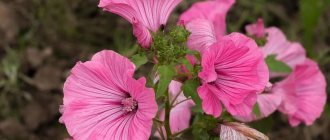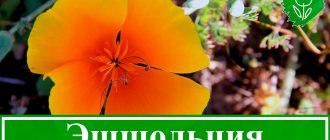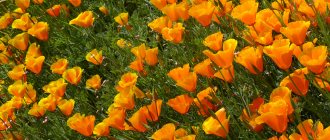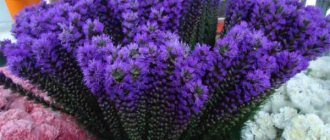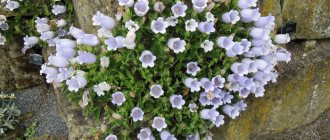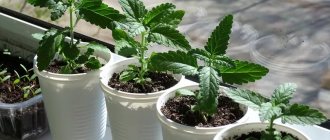Planting and caring for perennial alpine astramits requires classical knowledge of this genus, which has about 250 different varieties. In their natural habitat, perennials are widespread throughout the northern hemisphere. Plants are perfectly adapted to harsh living conditions. The culture is frost-, cold-, and stress-resistant and easily tolerates drought. Thanks to their unique qualities, alpine ground cover perennial asters are very popular among landscape designers.
Alpine aster is a unique stress-resistant ornamental plant cultivated by humans since the mid-16th century.
Description and characteristics
An amazing flower - the alpine aster is able to bloom in the same place for about 7 years without interruption. The period of intensive budding occurs in 3-4 years. The plant is characterized by the following external signs:
- stems are strong, erect, pubescent;
- stem height up to 40-50 cm;
- leaves are spatulate, ovate or lanceolate (depending on the variety), pubescent;
- inflorescences - single baskets with reed petals;
- diameter of inflorescences from 3 to 8 cm;
- the color of the inflorescences is various shades of white, red, blue, pink, blue, violet.
Every year, the root system of a perennial crop spreads a certain distance along a horizontal plane.
The photo shows an alpine perennial aster that can delight with the abundant flowering of chamomile-like inflorescences from May to September.
Alpine aster is a unique stress-resistant ornamental plant cultivated by humans since the mid-16th century.
Landing
Before planting an alpine aster, it is important to carefully and wisely select a location. The following tips can help with this:
- Although the aster prefers light-loving places, open sunlight can harm the plant. That is why it is better to stay in partial shade.
- The landing site must be protected from the wind.
- The shrub should not be in soil with constant moisture, as this can lead to rotting of the root system.
- It is necessary to drain the soil by adding sand to the hole.
Varieties of alpine perennial aster
One of the most popular herbaceous plants for open ground is the alpine aster. Various varieties are popular among landscape designers, florists and gardeners. Each of them is naturally endowed with original external parameters.
Different varieties of alpine perennial asters differ not only in their color diversity, but also in the shape of their inflorescences
Stained glass
The Vitrazh variety belongs to cold-resistant and frost-resistant crops. The height of the bushes is up to 50 cm. The leaves do not die off in the winter. Inflorescences are in the form of snow-white baskets of a single type, up to 5 cm in diameter.
Stained glass is used to form borders, the front line of mixborders, alpine slides
White Alps
The perennial alpine aster White Alps is characterized by a bush height of up to 30 cm. White chamomile-shaped flowers with yellow centers attract with abundant flowering from July to September.
The compact variety White Alps fits harmoniously into flowerbeds, mixborders, alpine slides, and is used for cutting
Blue
The large-flowered alpine perennial aster Blue (Blue) has a stem height of up to 50 cm. The flowering of numerous inflorescences is impressive with a blue-blue hue. The diameter of the Blue inflorescences is 6-8 cm. Each bush of the Blue Alpine aster is a separate bouquet, a complete composition.
The long-blooming variety of perennial aster Blue is one of the most popular and unpretentious varieties for border decoration.
Pink
Alpine Pink Aster is a stunning, popular ground cover variety that blooms early. The variety looks good in the foreground in prefabricated seasonal mixborders, complex figures with periodic color changes. The color of the inflorescences is pink, the diameter is up to 4 cm, the height of the bush is 25-30 cm.
Read more Sowing aster in open ground in spring: when to sow, care, photo
The flowering of the Pink Alpine star lasts from May to July; with the timely removal of faded inflorescences, the flowering period of the crop can be extended
Happy End variety
The winter-hardy variety of perennial aster Happy End is characterized by a height of up to 25-30 cm. The flowers are dark pink with a purple tint, a yellow center, and up to 4 mm in diameter. Happy End blooms in May-June.
Happy End asters are perfect for landscaping lawns, flower beds, mixed borders, borders
Illyria
Alpine aster Illyria compares favorably with other perennials with a diverse palette of shades of white, lilac, and blue. The height of the bushes is up to 20 cm, the diameter of the inflorescences is up to 5 cm.
The plant is used to decorate rocky alpine hills and multi-colored borders
Alpine blend
Perennial aster Alpine mixture is a popular and sought-after variety. The height of the stems is up to 30 cm, the diameter of chamomile inflorescences is up to 4 cm.
The culture is used for cutting, design of prefabricated flower beds
Sabina
The perennial Sabina belongs to the terry alpine varieties. The diameter of the original double purple inflorescences is up to 4 cm. The height of the Sabine bush is up to 20 cm.
The terry perennial aster Sabina looks original on alpine hills, in the foreground of flower beds
Popular varieties with photos
The most common varieties of alpine aster are:
- Albus;
- Gloria;
- Goliath;
- Rosea;
- Ruber.
When to plant alpine aster
The most popular method of propagating perennials is by seeds. Alpine aster is grown from seeds using seedlings and non-seedling methods (sowing in open ground).
Alpine aster seeds are sown for seedlings at the end of February or early March. Alpine aster seedlings are transferred to open ground at the end of May or early June after a consistently warm average daily temperature has been established.
In the southern regions, seeds are sown in open ground at the beginning of May or at the end of November before winter.
Plants grown from seeds sown in open ground begin to bloom within a year
Sowing seeds and caring for seedlings
Experienced gardeners distinguish two main methods for sowing seedlings of perennial alpine aster:
- classical sowing by deepening seeds treated with growth stimulants and disinfecting solutions;
- special sowing of alpine aster seeds in boiling water.
Growing alpine aster seedlings is a painstaking process, since the seed material does not have a high degree of germination.
Growing aster seedlings at home allows you to get beautifully flowering plants for decorating your local area.
Preparing containers and soil for growing seedlings
As a planting container, choose any container with sufficient drainage from broken bricks or expanded clay.
The soil should be loose and nutritious. This could be a universal mixture:
- garden soil;
- sand;
- peat;
- humus.
The soil is spilled with a solution of potassium permanganate for disinfection.
The seeds of perennial alpine asters have poor germination, so they are prepared for planting with growth stimulants and disinfected in a solution of potassium permanganate.
To prevent infection of seedlings with fungal infections, seeds of perennial alpine asters are treated with a 1.5% solution of potassium permanganate
Classic method of sowing seedlings
When sowing classically in containers, furrows are made up to 1-1.5 cm deep. The seeds are buried in the prepared soil mixture. Planting pattern:
- distance between rows - up to 8 cm;
- the distance between the seeds is up to 5 cm.
Read more Planting aster for seedlings: when and how to sow correctly, photo
The seeds are sprinkled with earth on top, and the container with the seeds is covered with plastic film or glass to create a greenhouse effect.
Comfortable microclimate for crops - sufficient level of illumination and air temperature not lower than +20⁰С
Special method of sowing seedlings
A special method for obtaining seedlings is to treat the crops with boiling water. As with classical planting, the prepared seeds are placed in a container with soil mixture, following the universal scheme. After distributing the planting material on the soil surface, the crops are spilled with boiling water, the container is covered with glass or film to ensure a greenhouse effect.
Seedling care
The container with the crops is placed in a warm place, on the south, well-lit side at room temperature not lower than +18-20⁰С. Watering is done as needed. After the emergence of seedlings, the shelter is removed and the temperature is lowered to +16-18⁰С. When 3-4 main leaves are formed, the seedlings are picked. The sprouts of perennial asters are hardened off 2 weeks before transplanting into open ground.
The seedlings should be watered in a timely manner, avoiding the formation of a crust on the soil surface.
How to use at home
- For chronic bronchitis or dry cough, use the infusion: take 1.5 tbsp. l. crushed alpine aster leaves and flowers. Brew the dry mixture with boiling water (1 cup) and leave for 45-50 minutes. Filter the medicine through gauze and consume 1 tbsp. l. four times a day. To increase the effectiveness of treatment, drink marshmallow syrup 1 tsp as an expectorant. up to 4 times a day.
- To treat ulcers, gastritis and other gastrointestinal problems, prepare the medicine according to the following recipe: grind dry medicinal raw materials into powder. Measure out 2 tbsp. l. of this powder and pour 350 ml of boiling water over it. Place the solution in a water bath for 10 minutes and then cool to room temperature. Strain it through a sieve or cheesecloth and drink ½ cup at a time. four times a day. To prevent the development of these ailments, drink ambrosia infusion.
- For hemorrhoids, this remedy will help: grind dry rhizomes into powder and measure 1 tsp. raw materials. Dilute it into 1 cup. clean water, then boil for 5 minutes over low heat. Leave the solution for 2 hours at room temperature and then strain. Drink the decoction three times a day, 125 ml.
- Rinse with the infusion for a sore throat or use it as a lotion for infectious eye diseases. To prepare a medicinal infusion, mix 1 tbsp. l. dry herbs with 200 ml of water. Boil the mixture for 3-5 minutes, then leave for 1 hour. For sore throat, gargle in the morning and evening. To treat eye diseases, make lotions from this infusion twice a day, applying them to your eyes for at least 30 minutes.
- To treat dermatitis, diathesis, eczema, furunculosis and various inflammations of the skin, prepare a product for external use: take 2 tbsp. l. dried Tartarian aster leaves, brew them with 500 ml of boiling water, cover the container with a lid and leave for 2 hours, wrapping the container in a towel. Use the finished drug to prepare lotions, which are applied to inflamed areas two or three times a day. For prevention, the medicine can be taken orally, 75 ml in the morning and evening. To speed up the process of skin cell regeneration, wipe the affected areas with aloe juice. The course of such therapy is 14 days.
Planting in open ground
Alpine aster seedlings are planted in open ground at the end of May or at the beginning of June when stable air and soil temperatures have been established during the day.
Since asters are light-loving crops, when choosing a place to place seedlings, it is necessary to give preference to open, well-lit areas without drafts.
The soil is dug up, fed with superphosphate and dolomite flour, peat, sand and humus are added.
Seedlings are placed in shallow holes along with a ball of earth, following the planting pattern:
- distance between bushes - up to 20 cm;
- the distance between rows is up to 40 cm.
After the seedlings are buried, grooves are made between the rows for watering
How to prepare flowers for winter: a collection of useful tips for summer residents
In order for perennials to again decorate the garden with abundant blooms next season, favorable conditions must be created for them from late autumn to early spring. We will talk about the wintering features of popular perennials.
Some perennial flowers are so unpretentious that they can winter in open ground without shelter or mulching. However, not all plants are so hardened and therefore require additional care.
Caring for aquilegia in autumn
Winter-hardy aquilegia (or catchment) does not need to be insulated. In October, the wilted shoots of the plant are cut off, leaving stumps 5-7 cm high, and mulched with dry leaves.
Astilbe in autumn - pruning, mulching and covering
Young astilbe also tolerates frosts well, so it is able to winter without shelter. In October-November, blackened shoots are cut off at the root and the base of the bush is mulched with peat or humus (about 5 cm layer). An adult plant (over 5 years old) is more picky, so additionally add dry leaves to the layer of mulch, and on top of them - non-woven material (spunbond) and plastic film, which will protect the perennial from precipitation.
How to care for perennial aster when cold weather arrives
Perennial asters bloom until late autumn; with the onset of persistent cold weather, they do not wither, but simply begin to dry out. Then their stems are cut off at the root and the base of the bush is mulched with dry leaves. Weakened plants are recommended to be additionally covered with spruce branches.
Pruning heuchera for the winter
Heuchera overwinters with its leaves. Only the flower stalks of this attractive plant are removed for the winter. With the arrival of the first frosts, they hill up the root collar and mulch the soil under the bushes with dry peat, humus and sphagnum. Closer to winter, when consistently frosty weather sets in, spruce branches are thrown onto the heuchera bushes.
What to do with delphinium in the fall
Delphinium can withstand temperatures down to –50°C, but only under a thick layer of snow. If snowless winters are possible in your region, it is better to play it safe and prepare a shelter for the plant. After flowering ends, cut off the flower stalks, leaving stumps about 15 cm high, cover the cuts with clay (this is necessary to prevent water from getting inside the stem) and when frost arrives, mulch the roots and cover the plant with spruce branches.
Dicentra - rules for preparing for winter
In the middle zone, a tender “broken heart” can freeze in winter, so you need to take good care of the plant. In the fall, the withered shoots are cut off, leaving stumps no more than 5 cm high, the base of the bush is mulched with peat and covered with a thick layer of spruce branches or spunbond.
How to properly prune and cover irises for the winter
Siberian irises (or iris) can overwinter without shelter. In autumn, dried stems are cut off, leaving stumps no higher than 10 cm, and the rhizome is well mulched. Varietal iris are more sensitive to frost, so an additional dry shelter is built for them and during the thaw, care is taken to ensure that moisture does not get on the roots of the plants.
Autumn care for lavender in the open ground
Only English (narrow-leaved) lavender can overwinter in the ground. In autumn, the stems of the plant are shortened 3 cm above the woody shoot, the soil is mulched, and in early November they are covered with a thick layer of spruce branches. But even English lavender does not always survive the winter well, especially in some regions with an unstable climate. With the onset of cold weather, it is better to transplant this heat-loving plant into containers and move it to a heated veranda or winter garden. It is also worth doing with other types of lavender.
Preparing daylilies for winter
After flowering ends, the flower stalks are immediately removed. When the leaves are completely withered and dry, they are cut off at the root. In late autumn, with the arrival of consistently cold days, the rhizomes of daylilies are mulched with peat. During severe frosts, spruce branches are laid on top of the mulch and snow is thrown on it.
Mallow needs special care in autumn
In the fall, after the entire above-ground part has withered, the plant is cut off almost at the root (only a small stump is left); in October-November (with the arrival of cold weather), the base of the bush is mulched with dry leaves, humus or peat. It is best to additionally cover young plants and varietal holly roses with double flowers with spruce branches, since in snowless winters they can freeze.
Is it necessary to prune monarda for the winter?
This rather frost-resistant flower will not cause you much trouble. For a comfortable wintering in the fall, it is enough to cut off the dried shoots, mulch the rhizome with peat, and when frost sets below –20°C, cover it with spruce branches or dry leaves (20 cm layer).
Preparing peonies for winter
In the fall (necessarily before the arrival of frost!) the above-ground part of the plant is cut off at a height of 10-15 cm from the surface of the earth and burned to get rid of pathogens and insect pests that have settled down to winter in plant debris. Then the peony rhizome is mulched with humus or rotted compost - this protects the renewal buds from frost. It is recommended to additionally cover the bushes planted this year with dry leaves or spruce branches.
Rudbeckia - proper care in autumn
About 2 weeks before the onset of cold weather, the stems of rudbeckia are cut off, leaving a stump 10 cm high, after which the rhizome is mulched with humus (a layer of about 7 cm), and dry leaves, hay are poured on top, or spruce branches are laid on top.
Nivyanik - features of pruning and winter mulching
These garden daisies, as a rule, are not afraid of frost. But varieties with large double flowers can freeze in a snowless winter, so before frost arrives, cut off the entire above-ground part to a rosette of leaves, mulch the soil around the bush with humus or peat, and with the onset of winter, dry leaves are poured on top (a layer of 15-20 cm).
How to cover paniculate phlox for the winter
Even before the onset of cold weather, phlox shoots are cut so that a stump 5-10 cm high remains. The rhizome is mounded with humus or compost and mulched with peat. In winters with little snow, when the soil has already frozen, one bucket of loose garden soil is poured onto the phlox bushes, and spruce branches or reeds are laid on top of the resulting mound.
Preparing hostas for winter
As soon as the hosta leaves wither and dry out, it is best to carefully trim them and mulch the roots with dry peat. Before the onset of frost, it would be a good idea to lay spruce branches or dry leaves on top of the mulch.
Caring for chrysanthemums in autumn and winter
To spend less time and effort preparing chrysanthemums for winter, plant flowers of zoned varieties. For example, varieties and hybrids of Korean chrysanthemum are best suited for the Moscow region. But these plants also need a winter coat.
Before the onset of frost, the above-ground part is cut to stumps 10 cm high, the base of the bushes is mounded with humus (10 cm layer), and mulched with dry peat on top of it. In a snowless winter, dry leaves are poured onto a layer of mulch, and then spruce branches are laid on them. If such a shelter does not save your chrysanthemums from freezing, dig them up, place them together with a lump of earth in a container and for the winter put it in a cellar with a temperature of 1 to 5 ° C.
We hope this article will help you maintain perennial plants even in harsh winters. And the attractive flowers will not disappoint you next season.
Source: https://www.ogorod.ru/ru/outdoor/perennial/10931/Kak-podgotovit-mnogoletnie-cvety-k-zime.htm
Growing and care in open ground
The perennial alpine aster is an unpretentious ornamental plant that requires minimal care in the open ground:
- moderate watering without waterlogging with soft, settled water;
- hilling bushes to strengthen the root system;
- loosening the soil to prevent the formation of a crust on the surface of the earth;
- mulching with pine needles or sawdust to block weed growth and retain moisture;
- fertilizing with potassium and phosphorus fertilizers in early spring after transplanting seedlings into open ground, mullein solution in June, wood ash in autumn;
- removal of weeds to prevent infection by fungal diseases and pests;
- removing faded inflorescences to ensure an aesthetic appearance;
- preparing for winter, trimming dried leaves and stems to the root collar, covering with dry leaves.
removing faded flowers stimulates the formation of new buds
Benefit
- Thanks to the presence of coumarins and saponins, aster has antipyretic, thinning and expectorant properties.
- An infusion prepared from its herb is an effective remedy against itching, furunculosis, irritation and other inflammations of the skin.
- Decoctions are effective for gastritis, ulcers, heartburn and other diseases of the digestive system.
- In oriental medicine it is used for diseases of the heart, lungs and urinary system.
- An infusion of dried flowers has a mucolytic effect and treats dry cough, bronchitis and even pulmonary tuberculosis.
- In folk medicine, the plant is used to treat joints, radiculitis, some eye diseases, and also as a pain reliever for headaches or migraines.
- Scientific studies have found that aster-based preparations suppress the development of Staphylococcus aureus, Escherichia coli bacteria and dysentery.
- A decoction of rhizomes is drunk to get rid of parasites, and is also used for fever and asthenia.
- Tibetan medicine uses an infusion of inflorescences as a means to increase libido in men.
- Tibetan healers gave it to women in labor to relieve pain, and also used it to stop postpartum bleeding.
Reproduction methods
There are several ways to propagate the alpine perennial aster:
- seed (seedlings and non-seedlings);
- vegetative (by dividing the bush and cuttings).
Read more When and how to properly collect aster seeds at home
Dividing the bush can be done throughout the summer season. Experienced gardeners recommend dividing the root system and replanting the mother bush at least once every 7 years.
Transplanting plants when dividing a bush stimulates flowering and improves the decorative properties of the crop
Dividing the bush
When dividing the bush, the mother plant is completely dug out of the ground, all dry, rotten stems, roots, and shoots are removed. The sections are treated with wood ash. The plots are planted in new places, in prepared and fertilized soil.
The aster can be planted in its original place after 5 years
Cuttings
Cuttings of alpine perennial asters are carried out in the spring. The apical branches with three viable leaves are cut from strong shoots. The cuttings are kept in root formation stimulants and planted in the prepared soil mixture:
- sand;
- peat;
- turf land.
The cuttings are covered with film, periodically ventilated and watered. They are transplanted to a permanent place in open ground in September.
Cuttings allow you to completely preserve varietal characteristics
How to choose a place for an aster
It is recommended to plant the crop in a garden and park area, in a flower bed. No matter where it grows, it will always please the eye. Heather aster feels great on the sunny side of the site. Can also be planted in light partial shade. Prefers loamy or sandy soil. It does not prefer excess moisture, so it should not be planted in places where groundwater lies nearby.
A good predecessor for this crop is calendula. You should not plant where gladioli or tulips previously grew, which transmit fungal diseases. Sentyabrinka, as it is also lovingly called by the people (pokrovka, oktyabrinka), intensively grows rhizomes. Gardeners recommend planting it on the south side of the site. Replant every 4-5 years to avoid the spread of pathogenic bacteria.
How to prepare a site for perennial aster
Preparatory work related to the soil begins in early autumn. They involve fertilizing the soil with humus and then digging it up. When the soil is not particularly fertile, mineral fertilizers (superphosphate, ammonium sulfate) are applied and harrowed forty to six centimeters deep.
Lime should be added to acidic soil. Placement of fine crushed stone is required when the soil moisture is high. Preparatory planting work consists of loosening the soil. It also needs to be cleared of weeds and sufficiently moistened.
When do alpine aster seedlings bloom?
Alpine aster seedlings produce flower stalks the following year after rooting in open ground. If it produces buds in the fall of the year the seedlings are planted, they should be cut off. Young plants that bloom in autumn may not survive winter well.
Most varieties of alpine perennial aster are characterized by a flowering period of May-July
Aftercare
Regardless of the chosen variety, Alpine aster does not require special care. To obtain lush, abundant flowering, it is important to comply with several requirements:
Watering
Aster is considered a moisture-loving plant. However, you should remember: to avoid moisture accumulation at the roots, the soil must have time to dry out between waterings. During heavy rains, watering should be stopped until the soil is completely dry.
Top dressing
It should be carried out in early spring. This will help the plant wake up and replenish the nutrients lost during the winter. One of the feeding options is a fertilizer from a mixture of 6 grams of nitrogen, 4 grams of phosphorus and 4 grams of potassium, calculated per 1 square meter.
Diseases and pests
Perennial asters are susceptible to infection by fungal pathogens: powdery mildew, fusarium, and blackleg. Diseases affect the root system, stems, foliage, and inflorescences.
When the first signs of disease are detected, the affected plants should be treated with solutions of modern fungicides (Topaz, Fitosporin)
Young shoots and leaves, unopened buds of asters are attacked by slugs, aphids, spider mites, cutworms if proper care is not taken. Modern insecticides (Karbofos, Actellik) help get rid of pests for a long time.
Timely removal of weeds allows you to resist attacks from parasitic insects
Possible diseases
Diseases avoid the plant with careful care. However, if it rains frequently in the summer and the planting site remains damp, the plant will develop powdery mildew. The disease has a fungal basis. Fungal spores affect the entire flower - from rhizome to bud. The problem can be easily avoided with the help of Topaz and Fundazol. In the autumn, most gardeners treat plants with copper sulfate, this protects the flower from late blight disease.
Asters planted in damp places become ill with fusarium, which affects the root system. The plant becomes brown, the leaves turn yellow and wither. Plants affected by the fungus should be promptly eliminated to prevent the disease from spreading throughout the area.
Jaundice, sclerotinia, pathological rust, and rhizoctonia are considered dangerous diseases. However, these diseases are less common. To increase the resistance of perennial plants to diseases, gardeners treat the area with zircon.
Application in landscape design
Perennial alpine asters are a magnificent decoration of the local area, park and garden areas. Plants are harmoniously combined and coexist with various ornamental crops:
- with non-flowering or inexpressively flowering ground cover plants (stachys, sedum);
- with flowering crops of different flowering periods (daffodils, tulips, chrysanthemums, marigolds, geraniums);
- low-growing varieties are especially relevant at different elevation levels of alpine hills;
- close plantings of alpine varieties of varying heights look beautiful next to phlox, daylilies, astilbe in original mixborders;
- in ridges along houses and various architectural forms;
- for decorating borders.
Chrysanthemums are excellent “neighbors” for perennial asters; in July they pick up the “relay” of flowering
Features of heather aster
Abundantly flowering inflorescences bend towards the ground, creating dense bushes. They are characterized by an oval-pyramidal shape. Gardeners have the opportunity to develop unusual compositions. A variety of baskets and flowers create a unique carpet. This culture is the best for developing landscape design in a garden or park.
Groundcover aster is characterized by abundant, long-lasting flowering. Heather aster can withstand temperatures down to −35 degrees. Heather aster is common in Europe and America. There it is planted in almost every garden plot.
What varieties of this species are there?
This crop is distinguished by its variety of varieties. It is also called a long-liver in the flowerbed, when other flowers have already faded, but it continues to delight the eye with its blooms. Herbstmyrthe is a gorgeous hybrid, over one meter high. The flowers are characterized by a white-lilac hue, the inflorescences are paniculate. The size in diameter is 10-12 mm. The flowers in the middle are yellow. They bloom in early September, delighting with flowering for a month and a half.
Erlkönig, this variety has a soft lilac petal color. The middle of the flower is bright yellow. The bush is characterized by branching, its height is no more than ten centimeters. Abundant flowering occurs in late September until November.
Bluestar is an unusual creeping heather aster. The bush reaches seventy centimeters in height. Since the foliage is small, needle-like, and the branches are squat, the heather aster resembles a low-growing conifer. Flowering continues from early August until the first frost, long and abundant.
Lady in Black is unusually decorative due to its almost black foliage, pinkish-brownish center and white tips of the petals. Many gardeners prefer this groundcover perennial for landscaping.
Aster heather snow town (Snow flurry) is a delightful ground cover that looks great in rock crevices and alpine slides. The abundant green carpet reaches only 10 cm and grows quickly. When flowering begins, the tiny white flowers resemble an avalanche. Hanging pots are well suited for growing hanging crops.
The pink cloud grows in the form of spherical bushes. Pale pink inflorescences are collected in numerous baskets. The variety is quite decorative; its charming appearance is maintained throughout the entire flowering period.
Many lovers of landscape design are attracted by the Golden Spray variety, which is a pyramidal bush in shape. The flowers are small, snow-white, and the center is deep yellow. It is quite large against the background of small flowers.
There are low-growing and tall-growing varieties. The latter includes the popular variety Royal Ruby, whose height reaches 1 m. The bush is quite vigorous. Paniculate inflorescences number up to 200 baskets. Flowering continues for two months.
